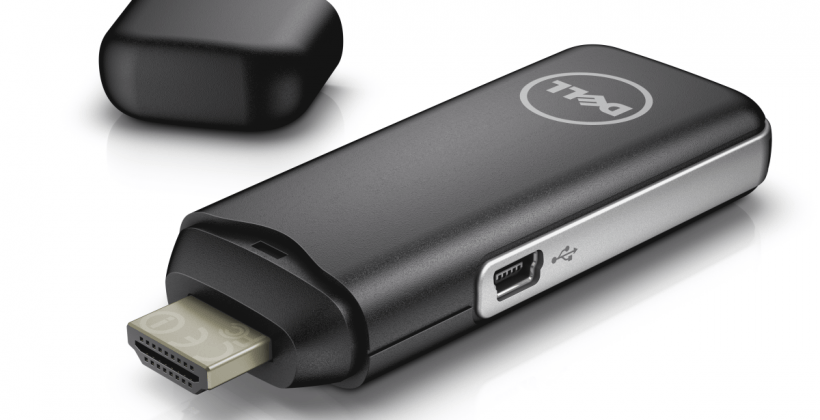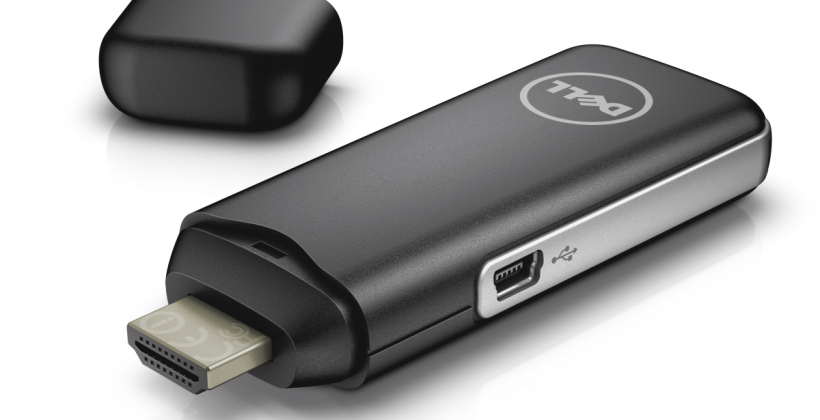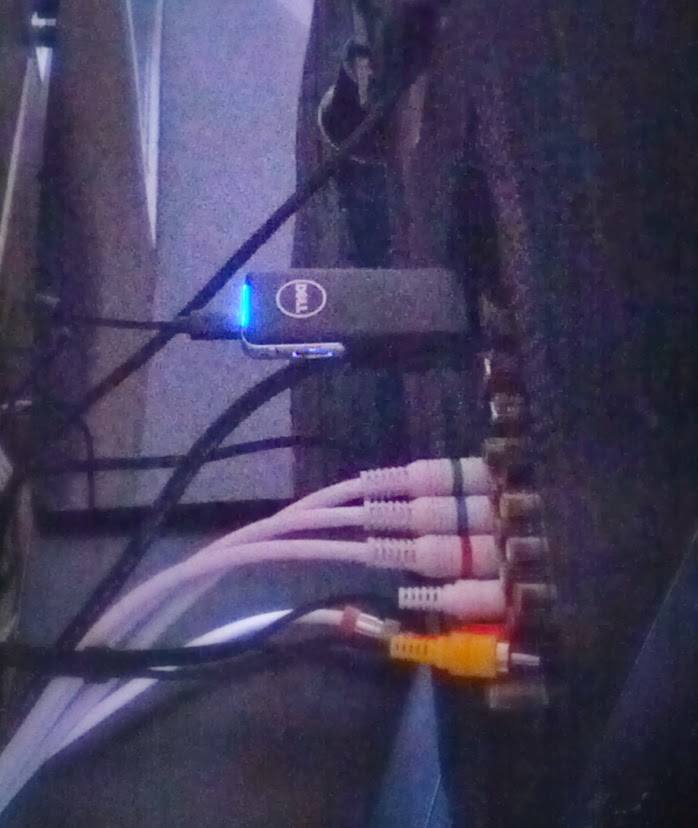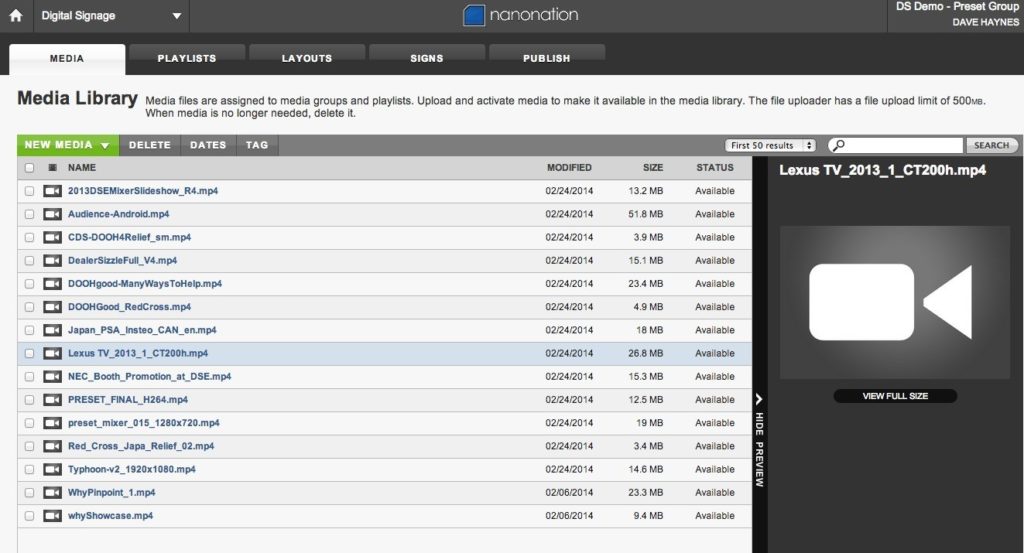
Lightning Review: Dell’s Cloud Connect HDMI Stick & Nanonation
February 25, 2014 by Dave Haynes

Let’s get one thing out of the way from the get-go. I don’t have a test bench or thingies that analyze voltage or heat or duty cycles or Higgs boson mass. I have a big-ass 50-inch plasma in the rec room, and it has a spare HDMI slot. So my lab test is not your final word on anything.
That said, when Dell announced its $129 USD wireless HDMI dongle and Nanonation demo’d it that day as a digital signage device, I thought, “Hmmm … I’d like to see that.”
You can’t order it up here because the polar bears would eat the delivery people, and probably also because Dell.com kicks you to Dell.ca the moment it sniffs out a Canadian. And Dell Canada didn’t stock it when I checked.
But the guys at Nanonation got me one, as well as a Bluetooth keyboard and mouse you need to get started (for now).
My umbrella opinion based on a couple of days of screwing around with the stick and the supporting software: Pretty good!
Getting started:
 The Dell Wyse Cloud Connect is about the same size and sets up the same way as a Google Chromecast stick. You plug it into a spare HDMI slot and power it from a USB port on the panel or, much better, an adapter plug and always-on power. TV goes off, and so does your Cloud Connect if it is plugged in the TV. Found that out.
The Dell Wyse Cloud Connect is about the same size and sets up the same way as a Google Chromecast stick. You plug it into a spare HDMI slot and power it from a USB port on the panel or, much better, an adapter plug and always-on power. TV goes off, and so does your Cloud Connect if it is plugged in the TV. Found that out.
There’s a little Bluetooth pairing button that got the keyboard and mouse running. You need both to launch the digital signage app and to key in your wifi password. It was quick and easy, but that fussy bit should be short-lived.
I have an Android phone, which helped me understand the little bits of navigation needed to launch the Digital Signage player. I let the pre-loaded Nano content run off the SD card for 24 hours to see if the motion graphics video started skipping or tearing, but the media stayed solid.
Software
Nano’s content management software was a simple web login and straight-ahead dashboard. I didn’t have instructions, and didn’t really want them. That way I was forced to figure out what to do, and happily, it was dead easy to upload new media files, build and edit a playlist, assign that playlist to a zone on a screen, and publish.

I had a set of new video files running in a matter of minutes, and they ran flawlessly over a second night.
The management console is pretty stripped-down compared to the full-featured Nano products I’ve seen in demos in the past, owing at least in part to the limited functionality of the device. You can divide the screen layout in up to eight zones, but why? It runs JPGs, PNGs and h.264 video at up to 1080P. RSS, Ticker and Weather widgets are not yet supported, but as I have ranted endlessly, it’s rare when tickers and weather make a lick of sense.
You can layer zones and target playlists by zone. You can set starts and stops down to the minute. You can schedule event-based playlists. Scheduling can be done via meta data, including exclusions based on tags. Right now you have to pull log files for reports but that will transition to auto-updates of reports. There’s expired file management built-in.
HTML5 support is coming soon, which will enable dynamic data updating templates. The use case would be things like menu boards in QSR.
Device management is pretty minimal, though you can set polling intervals and get notified if ET doesn’t call home after XX intervals. Nano has a very deep set of diagnostic tools that came out of its kiosk roots, so I think that is again only a matter of time before more visibility and control of the device will be enabled.
I’d say this version is best suited to networks with simple needs, like a set of videos and stills playing in a schedule. And there’s lots of those simple needs cases out there. Adding HTML5 support will be a big deal, as you can imagine how this cuts costs out of restaurant menu board jobs.

This is clearly the alpha version of the integration, and my guess is you will pretty quickly see some firmware tweaks from Dell and software tweaks from Nano to make this as simple as whipping it out of the box, plugging it in, and using scripting on the SD card to establish connectivity, auto launch the app and start getting downloaded instructions and media material.
Dell is by no means the first to put an Android stick on the market. There are several companies selling digital signage on Android sticks. The difference here, I suppose, is that I’ve actually heard of Dell and they are based in Austin, not across the Pacific in Shenzhen or Taipei. I’ve had a couple of Dell laptop nightmares, but with both of those, the “make it right” customer service was great. That matters with this stuff.
You’d have to talk to Nanonation about the commercial side of this, like how much for software, and SaaS subscription terms. This sort of thing strikes me as working best as a high volume, low demands thing – like simple merchandising videos across a retail group. You get into more sophisticated stuff, like interactive apps, you’re probably going to want the full Nano offer.
That said, it’s very interesting to see a networked gadget the size of a thumb drive doing what a $400-plus PC does, with no overly evident quality loss for what you see on screen.
Like I said off the top, my impressions are just impressions and I don’t have the tools, skills or inclination to do real testing. But from a product perspective, these things appear to have potential.



Leave a comment